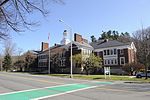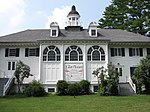Austen Riggs Center
1913 establishments in MassachusettsAll Wikipedia neutral point of view disputesAusten Riggs CenterHospitals established in 1913Psychiatric hospitals in Massachusetts ... and 5 more
Stockbridge, MassachusettsUse American English from May 2023Use mdy dates from May 2023Use mdy dates from October 2020Wikipedia neutral point of view disputes from October 2020

The Austen Riggs Center is a psychiatric treatment facility in Stockbridge, Massachusetts. It was founded by Austen Fox Riggs in 1913 as the Stockbridge Institute for the Study and Treatment of Psychoneuroses before being renamed in honor of Austen Riggs on July 21, 1919.
Excerpt from the Wikipedia article Austen Riggs Center (License: CC BY-SA 3.0, Authors, Images).Austen Riggs Center
Main Street,
Geographical coordinates (GPS) Address Phone number Website External links Nearby Places Show on map
Geographical coordinates (GPS)
| Latitude | Longitude |
|---|---|
| N 42.283083333333 ° | E -73.313305555556 ° |
Address
Austen Riggs Center
Main Street 25
01262
Massachusetts, United States
Open on Google Maps










